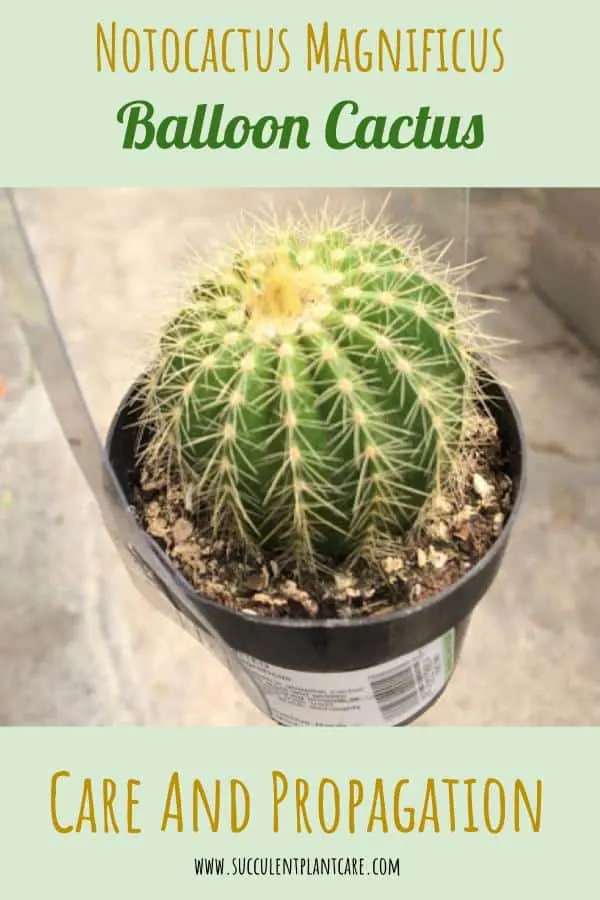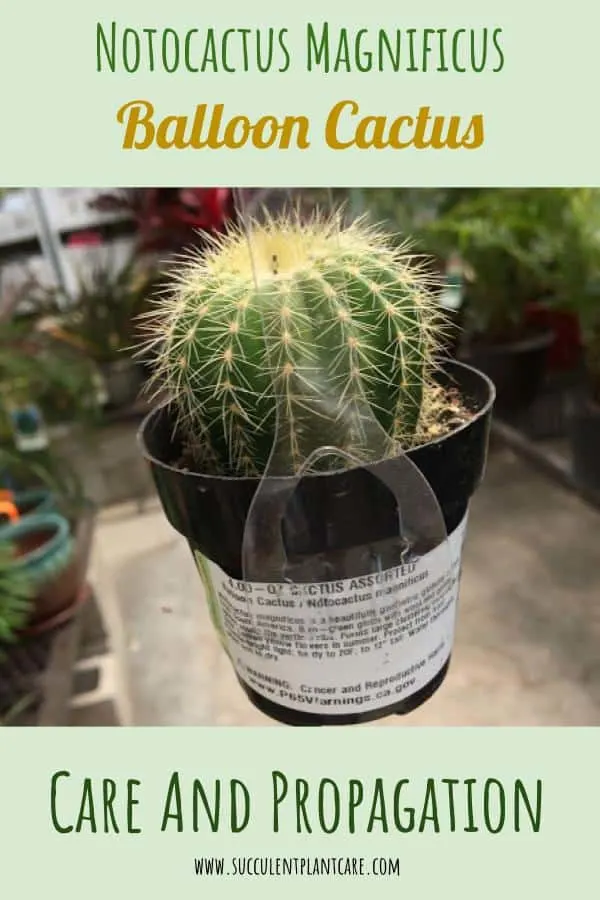Notocactus Magnificus ‘Balloon Cactus’, recently renamed as Parodia Magnifica, is native to South America, in the areas of southern Brazil, Uruguay, Paraguay and Argentina. It is a spherical cactus, blue-green in color, with yellowish and golden colored spines. This cactus usually grows in clusters but may also be solitary, depending on environmental factors. Some can get quite large over time, up to 12 inches (30.48cm) in diameter or more, but most will grow up to around 6 in. (15.24 cm) in diameter. They produce lovely light yellow flowers during the spring and summer months.

Is it an indoor or outdoor plant?
Notocactus magnificus/Parodia magnifica can be grown both indoors and out. Whether growing indoors or out, the most important requirement is to provide a very well-draining soil, plenty of light, and protect from freezing temperatures.
Indoor lighting requirements
The Notocactus magnificus needs plenty of bright light to survive and thrive. If growing the plant indoors, provide the brightest light possible. A south-facing window is preferred, or anywhere it can receive the most light. If this is not possible, try to provide the plant with some outdoor time during the warmer months.
Outdoor sun would almost always provide a brighter and more intense light than indoor lighting. Do take care when bringing the plant outside to do so gradually and avoid any abrupt change in sunlight. A plant that has grown accustomed to indoor lighting may suffer from sunburn when exposed to extreme sunlight all at once.
If the plant is kept indoors all year round and is not getting sufficient light, consider using a grow light to help supplement the lighting requirements of the plant. This plant will not do well in poor lighting for long periods of time. Click on my resource page to check the prices of some of the grow lights I recommend .
Outdoor sunlight requirements
The Notocactus magnificus will do well in partial shade to full sun. Place the plant anywhere it can receive bright light outdoors. As mentioned earlier, if bringing the plant out from inside, protect from intense heat initially to prevent sunburn or sun damage. Likewise, if the plant is a baby plant or fresh from the store or a garden center, gradually increase the amount of sunlight it receives outdoors to prevent from scorching the plant.
You can do this by placing the plant next to taller plants or under a chair or tree to provide some shade. You can also use sunshades to help protect your plants during extreme heat or heat waves. Here are some of my sunshade recommendations.
Morning sun is also tolerated better because it is less intense than afternoon sun. Mature plants or those that have been growing outdoors should be able to tolerate heat and full sun with no problems.
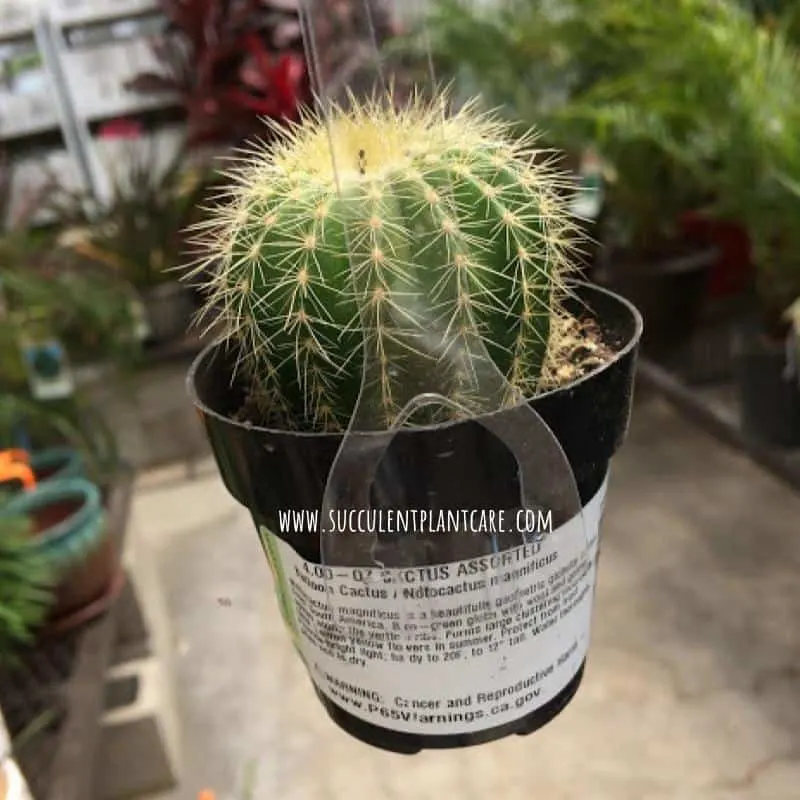
Frost Tolerance
The Notocactus magnificus will not tolerate frost for very long. The plant will tolerate up to around 20 °F (-6.7 °C). Anything below that and the plant will suffer. If you live in a climate with mild winters, you may be able to leave the plant outdoors all year long and even plant them in the ground.
However, if you live in an area with extreme winter conditions, the best way to grow these plants is in containers. That way you can move them indoors or move them in a greenhouse during the winter so they can be protected from freezing temperatures.
If you must keep them outdoors during wintertime, provide protection from frost by using a blanket or frost cloths. You can also set up a small greenhouse for your frost tender plants. Click here on my resource page to check for frost protection recommendations and prices.
Soil requirements
Is is important to provide a well-draining and porous soil to provide the best growing environment for the Notocactus magnificus. What I usually do is I use a standard cactus mix and combine it with perlite for extra drainage. I eyeball it to about 1:1 solution of cactus mix and perlite. You can also use a sandy mixture of coarse sand and cactus mix (1:1 solution). Or you can use a combination of these three materials (1:1:1 solution of cactus mix, perlite and coarse sand) for a porous soil mixture.
You can find most of these materials from a local garden center. To find them online and to check for prices, click on my resource page for my soil and soil amendment recommendations. To read more about this topic, visit my post on “Best Soil and Fertilizer for Cacti and Succulents” for further details.
Fertilizer requirements
If the plant has just been repotted in fresh potting mix, fertilizing is usually not necessary. However, nutrients do get lost overtime. You can replenish the nutrients lost in the soil by fertilizing during the growing season. Use ¼ to ½ strength of the recommended dosage on the label and feed or fertilize every two weeks to once a month. Here are my fertilizer recommendations specifically formulated for cacti and succulents.
These plants are slow growers and do not need to be repotted very often. In fact, you may not need to repot the plant as long as it does not outgrow its container. You may just need to replenish the nutrients lost from the soil overtime with fertilizers.
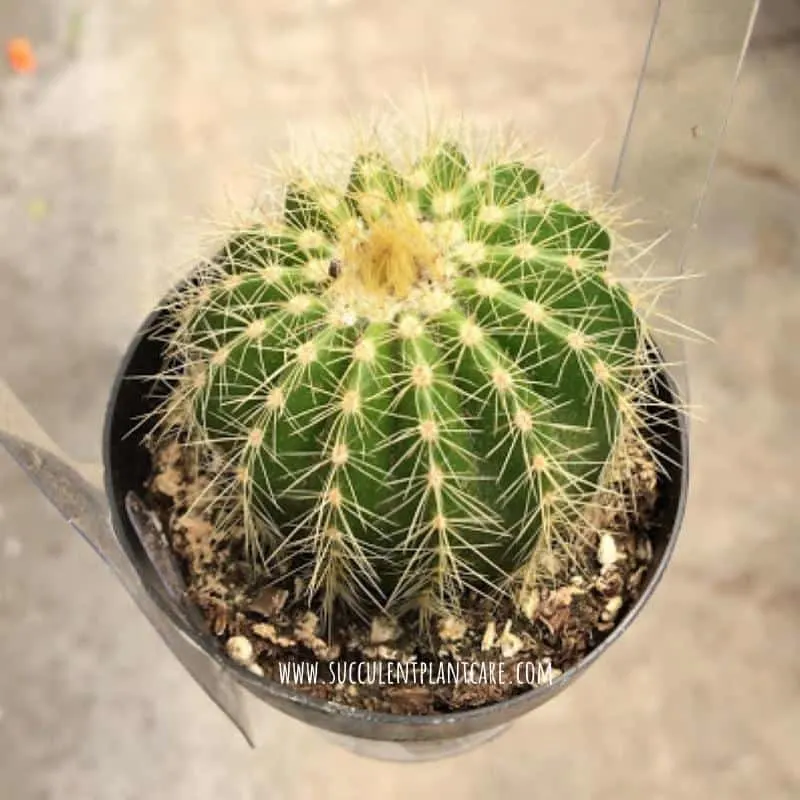
Watering requirements
The watering needs of your Notocactus magnificus varies according to the season and the size of the plant. An established plant needs less watering than a younger plant. Here are some general things you need to know about watering this plant.
In the summer months, water the plant thoroughly and deeply and do not water again until the soil is dry. The top inch of the soil needs to be dry before you water again. Otherwise the plant may suffer from too much water. Watering once every 10-14 days in the summer months is a good starting point. During a heatwave or extreme heat, you may need to water your plant more.
When the weather gets cooler during spring and fall, decrease watering. Water about every 2 weeks or so. Refrain from watering if the soil feels wet when touched.
During winter months, keep the plant relatively dry and only water to prevent the plant from drying out completely. If you live in an area where you get plenty of rain during the winter like I do, there is no need to water the plant at all. You may need to protect the plant from too much rain by moving the plant in the shade or providing protection from rain. If your area stays dry during the winter, watering the plant once every 3-4 weeks is more than sufficient.
If you feel like you need further help in gauging your plant’s watering needs, consider using tools to help measure the moisture level in the soil such as moisture meters and hygrometers. Here are some of my moisture meter recommendations to get you started.
Notocactus Magnificus Propagation
The Notocactus magnificus can be propagate by harvesting its seeds or by the offsets it produces. I have heard that harvesting and sowing the seeds of Notocactus magnificus for propagation is fairly easy. I have never tried it myself. Offsets are perhaps the best option of propagation for this particular cactus, but you would need to wait for offsets to grow and develop before this can take place. Luckily, these plants are known to form pups quite easily. Offsets form around the base of a mature plant.
Follow these steps to successfully propagate from offsets:
- Take care to gently remove the offsets from the mature plant. Wear protective gloves and use foam, cardboard, or other barrier to protect your fingers from the sharp spines.
- Place the offsets onto a piece of paper towel or in a dry location and allow them to dry out. This may take a few days depending on the humidity in your area.
- You will notice a scab-like growth forming over the cut area, which is called a callus. Optional: Once dry, you can dip the cut end in rooting hormone. Rooting hormone is optional and not a must but can help speed up rooting).
- Prepare a pot or small container with well-draining cactus growing soil.
- Once the offsets have dried, plant the callus edge into the soil.
- Water every few days or when the soil feels dry. Place the container in a bright spot but away from direct sunlight. Allow the plant to establish itself over a few weeks before exposing it to more sunlight.
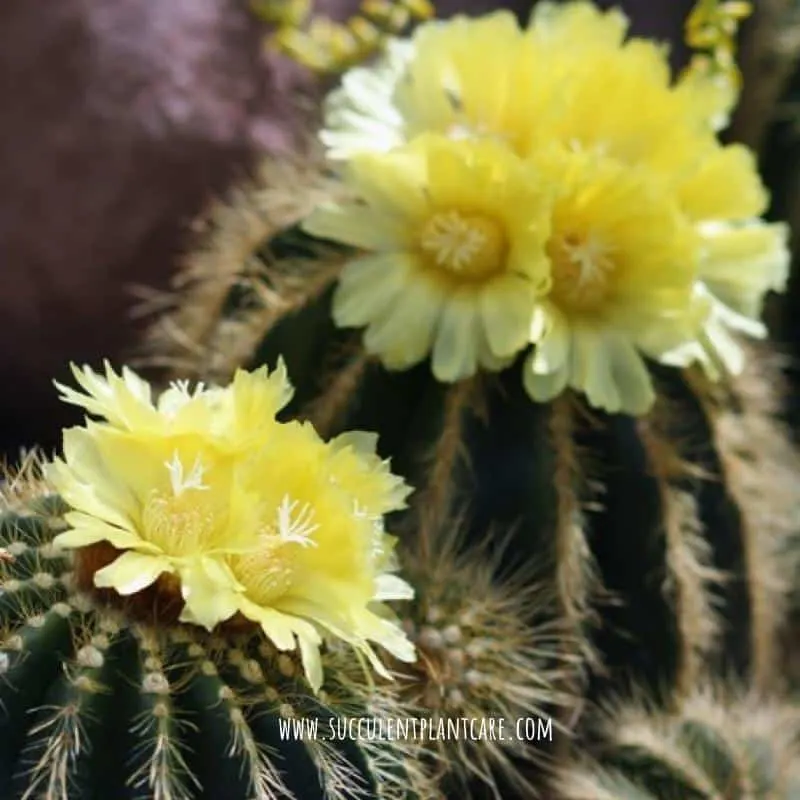
Notocactus Magnificus Blooms
The Notocactus magnificus produces bright, cheery yellow flowers. Plants that are ready to reproduce will flower. Keep in mind that not all cacti in cultivation will flower. Some may never flower at all. There are steps you can take to encourage blooms.
Encouraging better flowering requires a cooling period in winter. You should also hold back on watering during the winter months. Providing the Notocactus magnificus with too much water will deter flower growth. If the plant remains damp or sits in water for too long, the plant will fail to flower completely.
After reducing water to an absolute minimum during winter and allowing the plant to be somewhat dormant, you can boost flowering in the spring and summer months. You can do this by increasing your watering steadily and feeding the plant with a liquid fertilizer.
Fertilizers are better applied at a quarter or half strength, about every two weeks during the growing season. A balanced blend of fertilizer or a fertilizer formulated for cacti and succulents diluted to half strength are both suitable. Here are some of my fertilizer recommendations.
Is the plant toxic or poisonous?
The Notocactus magnificus is not known to be toxic to pets. However, due to the presence of sharp spines, care is needed when handling this plant to prevent injuries. If you suspect poisoning, contact your local veterinarian or poison control immediately.
Once established, Notocactus magificus ‘Balloon Cactus’ are easy, care-free plants that will last you for years to come and will reward you with happy blooms.
Wondering where you can find these and other cacti online? Visit my resource page for recommendations on where to purchase succulents and cacti.
Pin this to save for later or share with others now!
